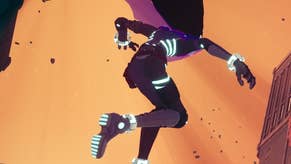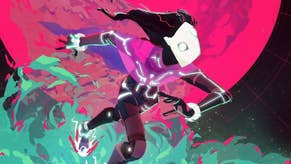Solar Ash review - Nothing breaks like a heart
Spine-tingling.
Late last night I stood in a floating church, looking up through the bones of the shattered ceiling towards the sky, where an island hung above me. The island was facing downwards, so where there should be stars, I saw patchy grass and the tops of noble pines. It was beautiful and teasing and I wondered how to get there.
This is Solar Ash, and Solar Ash is a skating game, really. It's a cosmic skating game with spectacular rinks and it absolutely does not want you to stop moving even for a second. You ghost frictionlessly over the landscape here, a thing of will and direction only. The earth curves away in strange, promising pathways. Connection is forgiving - even grind rails have a sort of mag-lev dreaminess to them, so you can hop on and off without much in the way of fiddliness. The sky is very clear and the ground is often cloud, soft duvet mounds of pearly blue that will hold you up but which, brilliantly, still see you disappearing into the blurred depths for a few early seconds before momentum carries you back to the surface. Dunked in a cloud: not a bad start to the day.
It makes sense. The whole thing is set inside a black hole, according to the fragmentary narrative, an old mosaic of a story that will reconstruct itself tile by tile if you have the energy to hunt for the pieces. There is a lost world that might yet be saved, and so you skate and skate while space and time do strange black-hole things. Schwarzschild! Mobius! We are in their world now, suspended. So you explore. You fight alien blob creatures with glowing eyes and beaks and mantles of bone. Brisk fights, each one, dealt with in a few sharp seconds as you pass by, ideally, without stopping. Fights that feel like a part of traversal rather than an interruption.
Beaks and bones! But despite the wild setting, there is order here too. In Solar Ash, you travel across a range of different platforming landscapes, and in each one you must destroy a series of targets in order to summon the landscape's resident beast. This is a giant thing, a landscape in itself really, so once it appears you must destroy that too and head on to the next landscape where the pattern repeats with smart variation.
This structure might seem similar to that of The Pathless, say, another elegant Annapurna-published game about exploration and the rushing joy of movement, in which you moved from one territory to another, doing three of this and four of that to summon a beast that must then be dispatched. But structure is all the two games really share. In The Pathless you must constantly earn your elastic momentum by firing arrows at scattered targets. Its levels are vast and often daringly open, putting me in mind of the kind of pencilled-in white-box spaces I have always imagined that developers conjure in order to test out new ideas.
In terms of level shape, The Pathless is in love with the basin or the valley. Solar Ash, meanwhile, likes snug, complicated spaces, corkscrews and pyramids and tangles. Manhattan skylines and Christmas trees. Propulsion is a ready gift here - it's waiting for you whenever you squeeze the trigger. Without that to earn, you must focus instead on excavating clean lines through these complex spaces, dancing from one spar of rock to another, climbing sprays of climbable black goop, threading a temple or tumbledown skyscraper, conjuring jump pads by smacking junction boxes, and creating whole new rails by jabbing strange fungal macaroons as you pass.
These landscapes are the soul of Solar Ash, and the game's greatest pleasures come when you reach a new area and see the glorious befuddlement that awaits. Thirties skyscrapers in one section, towers of commerce which you spin your way through while ducking the old subway trains scattered across the rails. The next area might turn the lights out and have you opening colour-coded doors by bathing in the right kind of alien spores. Then a toxic beach, where honeyed ruins sit under a sky filled with twisted filaments of cloud. The 3D art is of the soft, sun-baked kind. Stone feels warm and even the mushrooms look pleasant. And yet! The place is alive - that might be villi underfoot rather than grass - but it is also a fantasy of blooming death. The beaked things you smack around as you race by, the silent, long-vacated buildings towering overhead and underneath, the landmines that look like flu viruses and speak of futile conflicts. All that fungus too, I guess: life at its most disquieting.
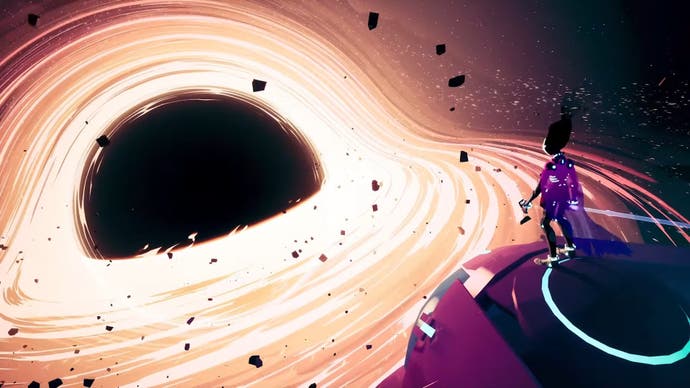
The landscapes fit together perfectly with your moveset. Use a trigger to skate and then pick a direction. Hop on rails to grind them. Fire up a rechargeable boost when you need that extra burst of speed. Use a limited slow-mo for tricky junctions, and use grapple points - or enemies - to lock on and snap right across the landscape and deliver a cosmic headbutt. At times, the audacity of the moves you're chaining together seems to pass from your side of the screen and over to the other. At times, the character you're controlling laughs out loud at the sheer wild nature of what you're both engaged in.
And those beasts. Each one is triggered by clearing out a handful of puddles of animalistic black goop located around the level. It's a traversal challenge really, as you move between attack points while a timer ticks down, before finishing everything off with a needle in the hot pink whale-eye of the puddle, which is somehow also a monster. Each of these you finish off clears the landscape a little and also brings the huge beast in the sky closer to wakefulness. When it finally does wake, you gamely grapple onto it and skate across its spiny surfaces - a spider basketball in one case, a withered phoenix in another - juddering between new attack points in increasingly tricky waves as the world rushes by beneath you.
It would not be hard to pull apart the dense braid of potential influences in Solar Ash, from the way your movement brings to mind the freewheeling joy of Jet Set Radio, to the manner in which the game delights in twisting the camera and sending you underneath an object you've spent the last half hour exploring from a different perspective, a la Mario Galaxy. And those beasts should probably invoke gaming's most famous colossi, or at least that sand bird from Mario Sunshine.

But they rarely do. What makes Solar Ash special, I think, is the fact that all these semi-familiar parts are filtered through a deeper set of influences that feel like entirely personal preoccupations - so personal that I'm not entirely sure they belong to the game and its designers or to me, the player, and I have just imagined them. I glimpse it, though, this deeper, richer game hiding inside the familiar one, moving around, stretching itself in confines. I glimpse it in the way a twist of rideable cloud will arc up overheard like a thickly myelinated nerve, or in the way the searing Icarus heroism of the Vangelis-tinged theme gives way to the alien burble and thud of human homeostasis on the soundtrack.
Isn't there something rather internal to this space? Could its enemies by neuroglia or macrophages, its landmarks lymph nodes or organs? Are these mushrooms scattered around or the perfumed synapses of neurons ready to discharge their atomiser bursts?
This brings me to the one videogame influence that cannot be ignored. Solar Ash is a kind of spiritual sequel to Hyper Light Drifter. Both games are created by the same team and, while I doubt that the stories connect cleanly, they absolutely pick away at the same wordless concerns. There is a lovely sense of progression between the games - from cloistered 2D to panoramic 3D, from sharp pixel art edges and grating stone to soft clouds, rounded hills, those globs of thick alien tar - and a continuity too. Both games love the quiet, empty moments that bring an extra thrill to the action when it finally arrives. Both love wilderness and rock. Both love to paint in a vibrating palette of Topshop colours, celebrating the strange harmonies of pinks and cyans particularly. Both are busy games about solitude.
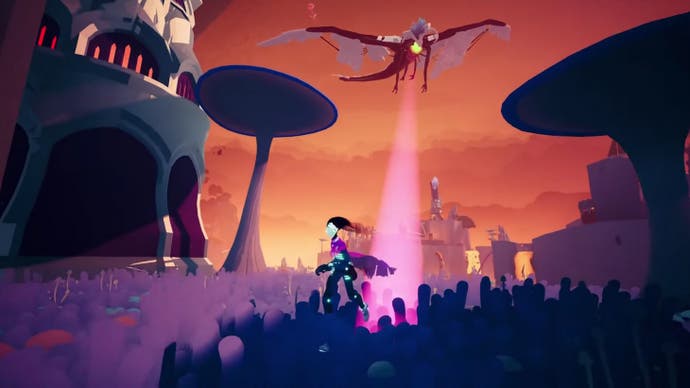
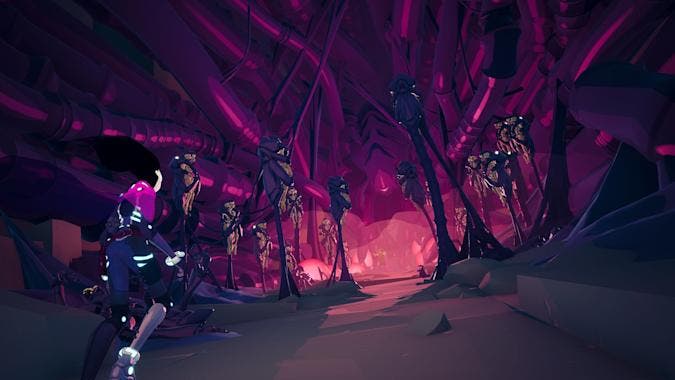
I played through Hyper Light Drifter twice, and only on the second playthrough did I really get a sense of the personal work churning away at the heart of this beautiful, precise, easy-to-market thing. And heart is probably the right word. Illness often skates in to a room trailing clouds of metaphor and analogy. It asks to be understood. And so you battle an illness. You dig in and will not let it win. Maybe your doctor throws the book at it. Hyper Light Drifter felt like it emerged from this analogising process a little: it was a thing that Alx Preston, the creative director of Heart Machine, had helped loom into being from his own experience - I think I remember this - with heart disease.
I played that game and felt I had been granted close access to a private metaphor of illness that could not entirely be understood from outside - and wasn't that the real beauty and power and the sheer privilege of it? And inevitably, I wondered: what happened next? Does the metaphor change over time?
All of which is to say: I don't know if you've ever had a lumbar puncture, but trust me when I say that Solar Ash may be the lumbar puncture-est game ever. Not a criticism! It makes sense, really: it's already Jet Set Radio in your limbic system, so why not throw in a dozen needles, striking right at the spine.
It's there with each boss you fight: you leap from bone to bone, from one vertebrae to the next, past rivers of goop that may be glossy threads of nerve. And those attack points you move between look a little too much like syringes for it to be a coincidence, surely? The medicalised body in all its terrible delicacy. You smash each syringe and move on, and there is that sense not just of progress, another node down, another beast taken care of, but of some deeper more painful kind of ongoing illumination. Is this stuff real? Does it matter? I'm tempted to say that, for me at least, this is the sort of thing that transformed Hyper Light Drifter from an elegant and voguish piece of design into a truly personal object, a glittering jewel formed at least in part by the pressure of Preston's own experience.
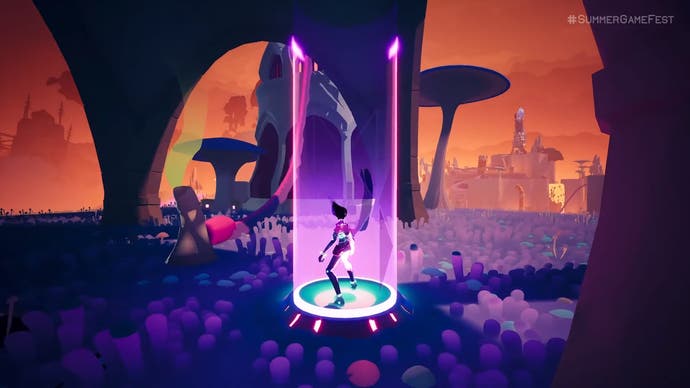
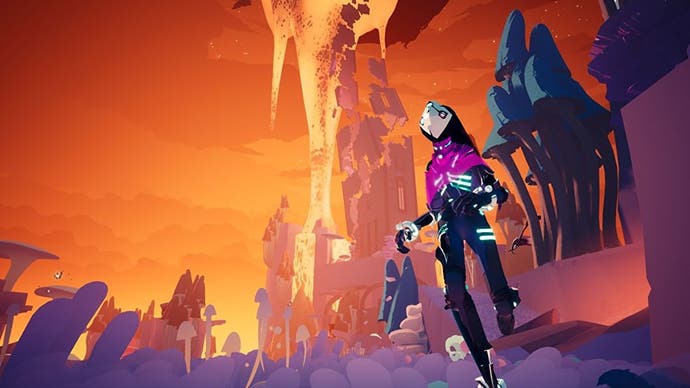
Of course, like any piece of art, Solar Ash is ultimately concerned with a constellation of things, some of them conflicting. I love that for the most part you are allowed to make your own connections and find your own meaning. Enthusiasms, worries, preoccupations, all books on the shelves here. Read what you want.
Speaking of books. Whenever I think back to Hyper Light Drifter, I think back to a library, high up in the mountains, shelves ragged and decayed, windows open to the bitter wind. An unforgettable place.
Well, I found a library here in Solar Ash too - last night, off the main path, hidden in a hollow in the earth. A dome-like space, with a tree coming through from above, roots tangled with the books that were piled and stacked everywhere. For a game about movement, it must have meant a lot to me that here I stopped for a while and just stood still to take it all in.






